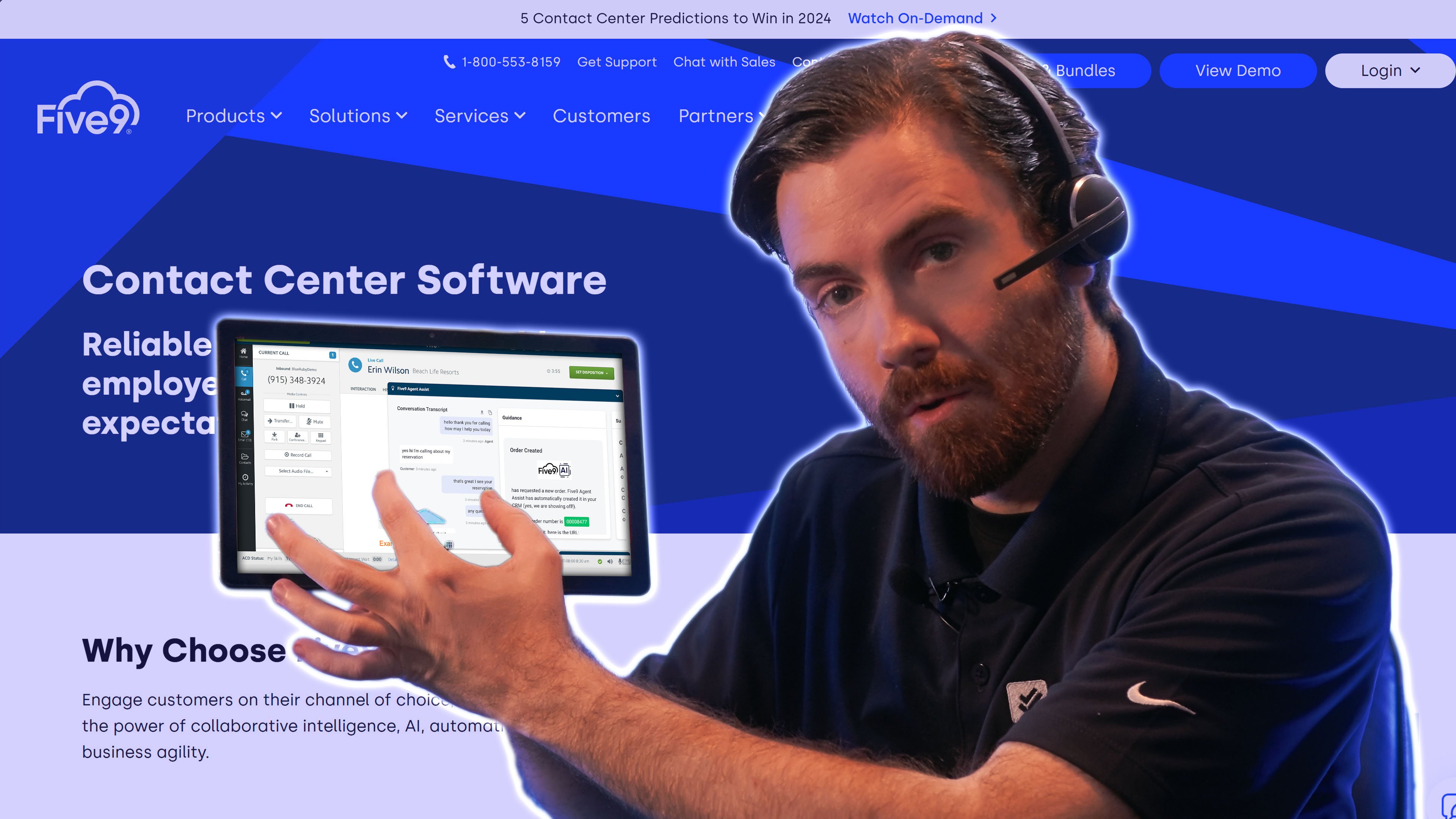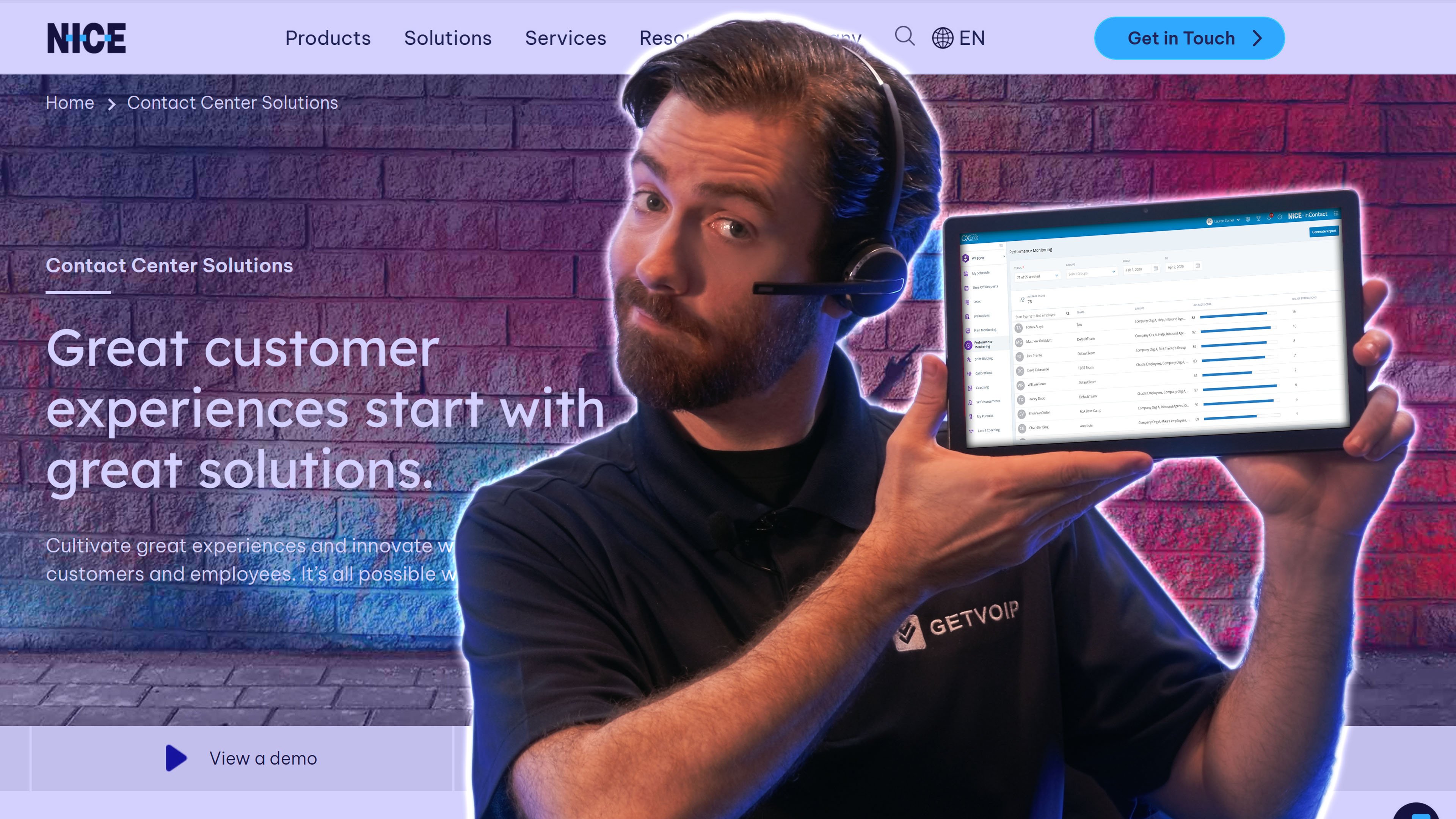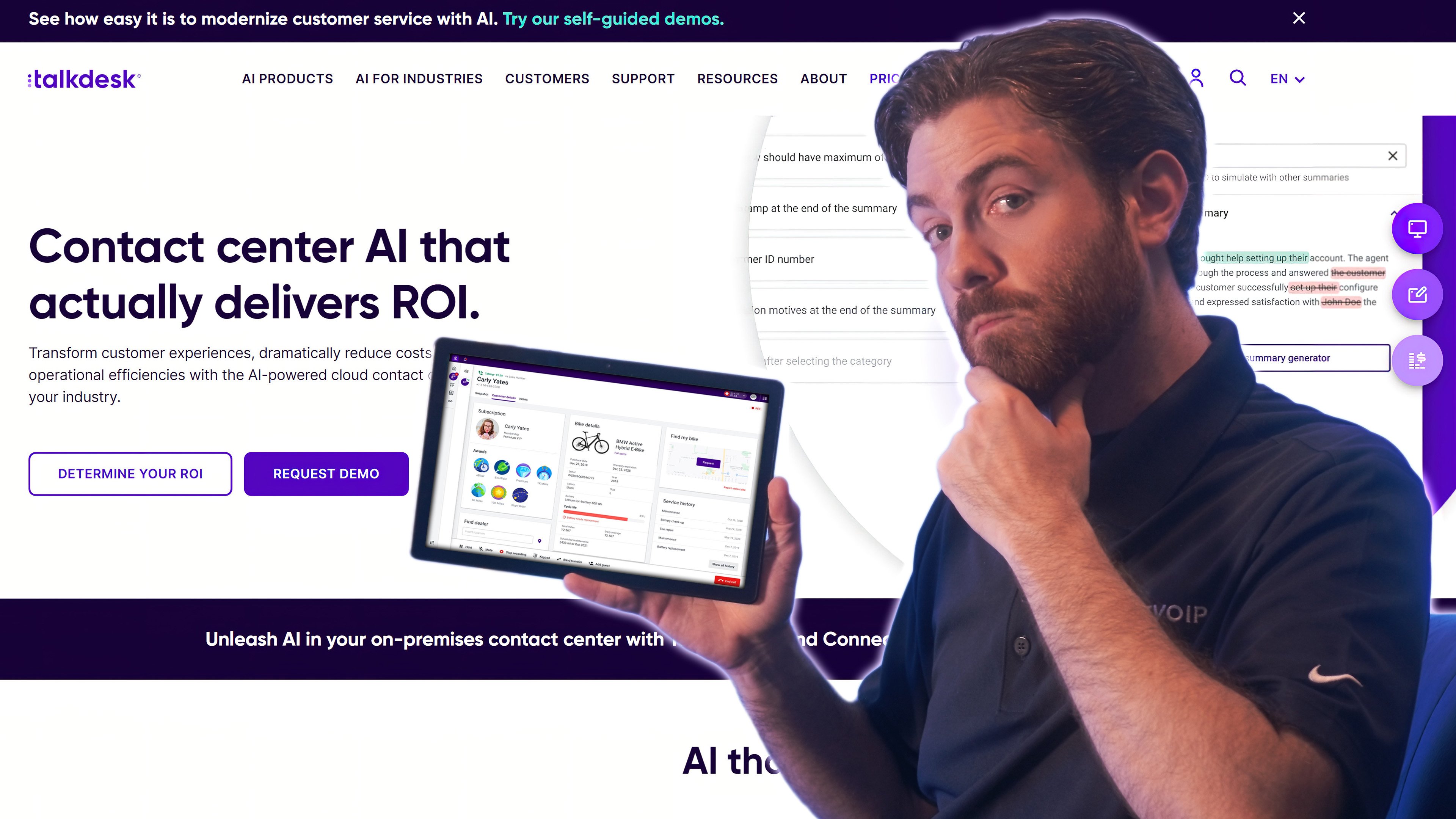Why you can trust GetVoIP + Our Research Methodology
We follow strict editorial guidelines and are committed to bringing you unique, independently researched, and valuable information.
We shopped each vendor on this list to finalize our picks for the best contact center workforce management software. We analyzed vendors according to important system features needed to efficiently manage your call center workforce, software limitations, costs, agent onboarding, user experience (mobile and desktop), agent performance handling, deployment, and each provider's communication channels.
We’ve validated every data point by calling, emailing, obtaining quotes, signing up for service, and live chatting with the service providers.
Editorial Note: We may earn a commission from partner links on GetVoIP guides. Commissions do not impact our opinions or evaluations. For a complete list of partners, please click on the advertiser disclosure link above.
Our latest report reveals our picks for the best contact center workforce management software. Written by seasoned contact center experts and analysts who conducted extensive hands-on research with leading vendors.
If there is something you'd like to see on this report or further assessed, please email Katherine Stone at katherine@getvoip.com.
- Overview
- How it Works
- Benefits
- Challenges
- Key Features
- AI & Automation
- KPIs to Track
- Best WFM Software
- How to Choose
What is Call Center Workforce Management Software?
Workforce Management (WFM) software in a call/contact center is a feature suite designed to monitor and optimize employee engagement and performance, streamline everyday workflows, improve the agent scheduling process, and identify trends in both customer and agent behavior.
WFM software increases employee and customer retention rates using insights from real-time/historical AI analytics, business process automation, multiple forecasting methods, customer feedback, and agent coaching.
The purpose of call center workforce management software is twofold: to improve the overall customer experience, and to improve internal business operations.
How Does Call Center WFM Software Work?
Workforce management software analyzes call center metrics that are specific to your organization and predetermined goals and then uses this information to make predictions, automate scheduling, and more. Here’s how it works:
Step 1: Input historical call volume data
After selecting a WFM provider, you can integrate the platform with any reporting and analytics software you are already using, and input all historical data. The more data you have, the more accurate predictions will be. If your call center does not have a lot of collected data, you can use the WFM platform to collect real-time data. In both cases, accuracy will continue to improve over time.
Step 2: System forecasts future demand
The WFM platform will use historical data to predict staffing needs for the future. This includes finding out when peak calls times are and how many agents are needed during these times to meet demand. WFM systems can also predict what kind of agents are needed during specific time periods, such as customer service specialists or tech support. Following these predictions will ensure that your call center is never over or under staffed, and that you have the right kind of support available.
Step 3: Set staffing rules and shift constraints
You can customize your WFM solution with staffing rules and shift constraints that reflect your goals and values. For example, giving shift preferences to more senior employees, setting a minimum or maximum for daily hours, or allowing shift swaps.
Step 4: Auto-generate optimized agent schedules
Once your WFM has enough data to make forecasts and your scheduling rules have been set, agent schedules will be automated by the WFM platform. The system will determine how many agents are needed for each shift and will then select agents to work based on availability and skill sets. Schedules will automatically be sent to agents with the opportunity to swap or put in requests for leave in accordance with predetermined guidelines.
Step 5: Monitor real-time adherence
Monitoring employee adherence and performance in real-time will allow you to see how accurate the predictions were as well as whether the system is working for your employees. Real-time monitoring will also allow supervisors to jump on difficult calls or assist agents that are having difficulty adjusting to the new system. Pay close attention to talk time, on hold time, and abandoned call metrics to ensure that things are moving in the right direction.
Step 6: Adjust staffing intraday if needed
During the initial implementation phase of your WFM system, it may be necessary to make staffing changes. This may be due to unforeseen challenges, such as an event that causes an unexpected surge in calls, or mistakes made in the data input phase, such as a sales agent being mislabeled as tech support in the system. In either case, monitor the call center closely for the first few days of implementation so that you can make immediate changes when needed.
Step 7: Analyze performance for future improvements
As everyone grows more comfortable with the WFM system, continue to monitor agent performance and KPIs like average queue time. You will want to ensure that wait times are decreasing, staffing levels are appropriate for call volume, and customer experience is improving. Once you see the WFM system work in real-time you will have a better idea of potential improvements in agent training and hiring.
Benefits of Using WFM Tools in Call Centers
The top benefits of WFM software for call and contact centers are:
- Decreased Operating Costs: CTI screen pops and optimized routing strategies lower cost per contact, improved scheduling eliminates the costs of hiring additional agents/paying overtime, task and resource management features prevent overspending
- Increased Agent Retention: Employee engagement features like performance gamification, self-managed schedules/PTO and time-off requests, payroll management, and business process automation provide opportunities for employee recognition, eliminate tedious manual tasks, improve team collaboration, and give agents autonomy
- Improved Agent Onboarding+Training: Call recordings let admins create playlists of successful customer-agent interactions for employee training, on-demand/automatic knowledge base integration displays canned responses, call scripts, and key support information on agent screens, real-time agent performance coaching via live chat and call scoring sheets clarifies performance expectations, AI insights identify gaps in overall agent training
- A Better Customer Experience: Customers can reach out on their preferred voice/digital communication channel and switch between channels during a single interaction, customers receive consistent, standardized responses to support queries, more efficient call paths and intelligent routing decrease hold times and shorten average handle time, customers provide feedback via automated surveys
- Streamlined Business Processes: Automated data entry, custom call handling rules and triggers, omnichannel customer self-service with IVA/chatbots, real-time schedule adjustments, and automated call scoring free up agents, increase productivity, and ensure customer follow-ups
- Insight Into Customer Behavior: Automated sentiment analysis, topic clustering/word clouds, AI speech and text analytics, call recording/transcription, survey responses, KPI alerts, and live interaction monitoring provides high-level insight into customer demographics, needs/preferences, buying patterns, pain points, and more
- Increased Customer Loyalty: Improved CX, omnichannel self-service, shorter support resolution times, and targeted marketing campaigns increase CSAT/NPS scores and improve customer retention rates
- Optimized Schedules: Forecasting identifies peak call times and ensures staffing needs (both the number of agents and the required skill sets) are always met
- Fewer Miscommunications: Process automation reduces human error, team collaboration tools (chat/video messaging, file sharing, etc.) let agents communicate across time zones/locations in real-time, asynchronous omnichannel shared inbox ensures all team members have access to the same file versions and task updates
Challenges with Managing Workforce in Call Centers
The top three challenges of call and contact center workforce management are:
High Employee Turnover
Burnout from repetitive tasks, a lack of performance feedback, aggression from unhappy customers, and a lack of team collaboration are the main reasons why call centers have a notoriously high employee turnover rate of about 30-45%.[*]
Call center software increases agent retention rates with customer self-service, gamification, detailed performance scoring, employee recognition, and high-level automation to eliminate tedious tasks. It also integrates with popular team collaboration tools (or offers native collaboration features) to engage remote and geographically diverse agents.
Scheduling Issues
Remote, in-house, and blended call centers of all sizes struggle with effective agent scheduling and allocation strategies–especially in peak seasons.
Call center workforce management software offers automated intraday management, an agent portal for shift bidding/PTO requests, and suggested schedules informed by forecasting trends and past call volume data. It prevents overstaffing by optimizing available agents.
Inconsistent Training
Inconsistent agent training leads to miscommunication, a poor customer experience, longer handle times, and ultimately, lost business. Training has such a big impact on contact centers that 70% of agents who felt supported during training also experienced less burnout compared to their peers.[*]
Workforce management software includes customizable and template-based training modules that can be automatically assigned to agents after a less successful interaction.
Call recordings provide examples of quality customer service, and WFM analytics identify common problems before they spiral out of control. Custom onboarding and software training packages for admins/agents are available, as are on-demand webinars. Plus, most workforce management tools integrate with existing helpdesk/internal knowledge base software–ensuring agents all provide consistent, up-to-date responses to customer queries.
Key Features of Call Center Workforce Management Software
The most important features to manage workforce in call centers are:
Trend Forecasting
WFM trend forecasting uses predictive/historical analytics to help managers anticipate and prepare for upcoming changes to call center activity. Forecasting gives managers the time and data needed to respond to shifts in customer behavior and buying patterns, prepare for peak seasons and shifts in contact volume, manage staffing levels, optimize automated workflows, and adjust agent workloads.
There are several types of automated and manual forecasting methods, including “What If” scenarios, benchmarking, objective-based forecasting, and template-based forecasting.
Agent Scheduling
Workforce scheduling tools use trend forecasting and AI analytics to optimize upcoming agent schedules. These features ensure each shift has not only the optimal number of agents working, but also a variety of skill sets, department representatives, communication channels, and call flow paths.
These tools create automated suggested schedules, make real-time adjustments according to live KPIs and service levels, and monitor agent adherence. WFM scheduling features also include shift bidding and swaps, PTO management, automated approvals for schedule changes, and intraday management.
Performance Management
Performance management (quality management) is a suite of WFM tools that provide deep insights into customer support quality, the agent experience, and agent understanding of current training materials.
Performance management includes features like agent scorecards, real-time agent monitoring, in-call coaching (via chat or call whisper), time tracking, training module assignment, call recording/transcription, and call summaries.
Employee Engagement
Employee engagement, a major buzzword in the WFM space, includes features like performance gamification, live leaderboards, team chat messaging, task management, and employee recognition. Employee engagement WFM capabilities are designed to increase agent retention rates, boost productivity, foster team collaboration, and make agents feel valued. These tools also help admins recognize top performers and identify trends in agent behavior.
Integrations and CTI Screen Pops
WFM solutions should integrate with the most popular third-party business applications, but especially with CRM systems, team collaboration tools, and helpdesk software. These integrations enable real-time CTI screen pops and AI Agent Assist, which show essential customer and historical data, ticketing rules, call scripts, canned responses, support protocols, and other internal information directly on an agent’s screen without requiring app switching.
Customer Surveys
Quality Workforce management system software includes custom and template-based customer surveys in a variety of formats (multiple choice, rankings, open-ended questions, Net Promoter Score and Customer Satisfaction Score, etc.) Admins can configure automated post-contact surveys across voice and digital channels, as well as view customer surveys results in real-time.
Conversation Intelligence
Conversation Intelligence is a WFO feature that monitors 100% of customer-agent interactions across voice and digital channels. It uses speech recognition, natural language understanding, and machine learning to identify root causes of customer complaints, find gaps in agent training, and conduct intent or customer sentiment analysis.
Conversation Intelligence reports can be drilled down by date range, department, customer, channel, or individual agent. These reports are usually interactive in nature and include charts, graphs, color-coded KPIs, word clouds.
Custom Call Rules+Routing
Workforce optimization tools should also have advanced call/contact rules and routing strategies to shorten wait times, enhance the customer support process, and increase productivity.
Admins can choose from a variety of routing strategies (skills-based, most idle, round robin, business hour routing, etc.) and adjust call flows or ring groups in real-time to optimize available agents.
AI & Automation in Workforce Management
About 98% of all contact centers now use AI-powered tools such as forecasting call volume and agent scheduling needs.[*] Advancements in AI technology and machine learning have led to more streamlined platforms that can automate almost all of workforce management and engagement tasks, improving over time. This frees up supervisors for more important tasks and makes life easier for agents. Here are some of the ways that AI and automation is used in workforce management:
- Predicts call volumes with higher accuracy: Artificial intelligence has the ability to synthesize large amounts of data or make forecasts off very little data, using information from multiple public sources. Accuracy will increase overtime as the AI model learns the business and gathers more data
- Auto-adjusts schedules in real time based on demand: AI-powered scheduling tools can automatically make adjustments when there is a lull or surge in call volume, decreasing corporate waste
- Flags adherence or occupancy issues instantly: AI-powered WFM systems automatically track adherence and are able to notify on call supervisors immediately when agents are late or don’t show up
- Suggests shift swaps or reassignments: AI tools are experts at spotting trends and are well suited to make suggestions on shift reassignments. For example, if one agent repeatedly asks for time off on school holidays, the system may suggest scheduling a different agent for shifts that fall on school holidays
- Automates repetitive admin tasks (e.g., approvals, time-off requests): AI-powered tools are able to streamline the time-off approval process by providing supervisors with all of the context they need to make an informed decision; such as available coverage and approval history. Shift swaps can also be automated
- Learns from past patterns to improve forecasting: One of the biggest advantages of AI is machine learning- the ability of an AI-powered tool to train itself and become more customized to your specific call center by learning agents habits, customers needs, and call volume fluctuations
Workforce Management KPIs to Track
WFM/WEM systems are used to track a number of important metrics. Supervisors can receive alerts and automated reports to ensure that compliance, engagement and CX goals are being met. Here are some key workforce management KPIs to track:
- Call volume: Call volume is the number of incoming calls your receive in a given time period and it works hand in hand with WFM/WEM platforms to properly staff the call center
- Attendance Rate: Tells you what percentage of employees are reporting for work on time when scheduled. Low attendance could indicate that stricter protocols or more predictable schedules are needed
- Agent Turnover: Informs what percentage of your total employees are leaving the business (voluntarily or terminated) during a specified time frame. High turnover could indicate high levels of stress on the job
- Agent Engagement: Measures how motivated and committed agents are and is usually measured by surveys given to supervisors or fellow agents
- Agent Overtime: Tells you what percentage of your employees time is overtime. High overtime rates could mean your call center is understaffed
- Agent Productivity: Informs you of an agent's overall productivity by measuring tasks completed, calls handled, sales made, etc.
- Schedule Adherence: Keeps you informed of how strictly schedules are followed, how often employees are swapping shifts, requesting time off, etc.
- Average Wait Time: The average amount of time that callers are placed on hold. As WFM improves, you should see average wait times decrease
Best Workforce Management Software for Call Centers
- Five9- Best for Enterprise-level omnichannel contact centers
- NICE CXone- Best for teams in that want to automate data collection
- Talkdesk- Best for Medium-to-large businesses needing industry-specific software
- Genesys- Best for digital-first contact centers with advanced scheduling needs
- 8x8- Best for remote teams needing an all-in-one CCaaS, UCaaS, and WFM solution
- Nextiva- Best for contact centers that use social media as a primary support channel
Five9

Five9 is a robust CCaaS platform with AI-powered tools such as Agent Assist, live call summaries, automated agent scheduling with intraday management, adherence monitoring, and real-time agent coaching. It helps enterprise-level omnichannel contact centers optimize schedules, monitor and score agent performance, and integrate with internal knowledge bases/CRM systems to eliminate app switching and decrease handling time.
What We Like
- Gamification: Performance gamification with live leaderboards, custom challenges, and rewards boosts employee engagement and productivity
- Agent Portal for self-service: Agent portal lets employees bid on shifts, monitor/request changes to their work schedules, review assigned coaching modules/performance feedback, and customize their dashboard interface
- Advanced QM: Five9 Quality Management lets admins review and annotate voice/digital interaction transcripts and voice/screen recordings, create custom agent evaluations, or provide live feedback via chat messaging
- Analytics: Five9 uses AI to analyze 100% of customer-agent interactions and highlight actionable CX insights
- Pre-built CRM integrations: Salesforce, Zendesk, ServiceNow, and Oracle Service Cloud (among others) use CTI screen pops and AI Agent Assist to empower agents with real-time customer data and relevant support information from internal wikis
What to Know
Advanced features mean Five9 requires a longer onboarding process than competitors and may create an overcrowded interface with near-constant push notifications/alerts. SMS, MMS, and social media messaging must be purchased as add-ons for all plans except the affordable Digital Plan–which doesn’t include voice calling or any workforce engagement features. Finally, interaction analytics are only included in the most expensive plan.
Cost
Five9 offers 5 plans starting at $119 monthly, per user. Users can choose between a digital only, voice only, or omnichannel plan. WFM and WEM tools are only included in the upper tier plans (Optimum and Ultimate plans).
For more information, see our Five9 pricing guide.
NICE CXone

The NICE CXone cloud-based omnichannel contact center solution includes 40+ voice and digital channels enriched with Enlighten Conversational AI, an AI-powered Workforce Engagement Suite.
Admins can optimize workflows, contact center operations, and the customer journey with over 40 forecasting algorithms, automated schedule adjustments, if-then intelligent routing, and automated risk management.
What We Like
- Voice and screen recording: Admins can set custom recording retention policies, download/share recordings, and add virtual sticky notes, tags, and annotations to improve employee performance
- Engagement manager: Admins and agents monitor performance and optimize workflows with automated interaction scoring and smart coaching assignments
- Enlighten XO: Speech/text intent and predictive analytics create/refine self-service scripts and automate processes like order processing, bill payment, account verification, and escalation matrix initiation
- Best Pick Technology: Advanced desktop/mobile employee scheduling automation with Best Pick technology to ensure each shift has agents from all departments and with a variety of skills, training, and availability
- Enlighten Copilot/Auto-summary: In-conversation CTI screen pops provide agents with next-best action suggestions from both internal knowledge bases and Google Search results, plus automated post-contact summaries
What to Know
NICE CXone’s asynchronous omnichannel MAX (My Agent eXperience) interface is overcrowded, especially when multi-channel and omnichannel handling is enabled--leading to missed customer interactions. It also does not include native UC/collaboration tools like team chat messaging and web conferencing, leading to internal miscommunications. Finally, NICE CXone’s online knowledge base is outdated and uses multiple names for the same product, leading to confusion during the purchasing/onboarding process.
Cost
NICE CXone offers six plans ranging in price from $71 to $209 per user, per month. The lowest tier plan is digital only and the next tier up is voice only with self service capabilities. All other plans include both voice and digital channels with omnichannel routing and universal queues.
For more information, see our NICE CXone pricing guide.
Talkdesk

Talkdesk CX Cloud is a contact center software solution with advanced WFM, Quality Management, and Performance Management suites.
Talkdesk Workflow Management (WFM) analyzes past data to predict/project future KPIs, scheduling/staffing needs, and automation opportunities. It conducts intraday forecasting every 30 minutes, automatically updates schedules, suggests skills-based schedules, and predicts AHT and contact volume. Admins can manually adjust schedules and agents can request schedule changes/add events via conversational chatbots.
Talkdesk Performance Management analyzes 100% of interactions across channels to evaluate customer sentiment and support trends.
What We Like
- Utterance Audio Player: Identifies key moments in conversations and lets mins/agents search for keywords, access in-conversation coaching, review intent analytics, and more
- 60+ integrations: Integrates with third-party tools like Slack, Zooom, Microsoft Teams, Zoho, Zendesk, and Pipedrive
- Workspace templates: Intuitive dashboard templates by user role (Admin, Agent, Supervisor) with custom integrations, icons/toolbars, languages, and real-time push notifications.
- Conversations interface: Voice/digital omnichannel inbox where agents can review assigned interactions, communicate with customers in real-time, filter conversations, add/review notes and response templates, and complete after-contact work
- Customer Experience Analytics Suite: 900+ historical CCaaS metrics, 17 real-time reporting dashboards, omnichannel CSAT/NPS scoring, and performance management with team leaderboards
What to Know
Talkdesk does not offer native video conferencing. Additionally, several advanced features including Agent Assist, omnichannel analytics, and Talkdesk Guardian for high level security, are only included in their limited “starter version” in the more affordable Talkdesk plans.
Cost
Talkdesk offers three bundled monthly CX Cloud (CCaaS) plans from $27-$125/user/month. It also provides a variety of industry-specific Experience Cloud packages including a FedRAMP Edition and models for banking, insurance, healthcare, and retail. Workforce Management is available as an add-on option for all plans, and performance management features are included in the CX Cloud Elite plan. Additional add-ons include the Proactive Outbound Engagement suite, Agent Assist, and Customer Experience Analytics.
For more information, see our Talkdesk pricing guide.
Genesys

The Genesys cloud contact center includes a WFM system and offers the Cloud EX add-on for workforce engagement. Genesys WFM features include performance gamification, agent assist, evaluations and learning module assignment, continuous forecasting with long-term workforce planning, and speech/text analytics with sentiment analysis.
Admins can set up live or automated omnichannel predictive engagement to anticipate customer needs, segment customers by intent and priority, or create predictive customer journey maps or scenario models. Intelligent omnichannel routing with comparison testing and a summary of business benefits is also available.
Geneyss pre-built app integrations include Zendesk, Zoho CRM, Freshworks, Salesforce, Oracle, Dynamics 365, and ServiceNow.
What We Like
- Interaction Toolbox: Agents can access in-conversation customer data including CRM information, contact information, customer journey maps with recent website activity, one-click ticket management, conversation history, and customer-agent co-browsing
- Personalized Employee Hub: Custom agent dashboards give agents a 360-degree view of daily/weekly tasks and activities like evaluations, assigned learning modules, leaderboard/gamification updates, recent customer interaction data, color-coded schedules, and performance score trends
- Agent Scheduling: Create or manage schedules for up to 5,000 agents for a maximum of 6 weeks on desktop/mobile devices, access shared calendars and PTO management, shift trading, automated scheduling, schedule bidding, skills-based scheduling, combination scheduling
- Work Automation Suite: Includes advanced task management with multi-source task creation and task filtering, custom task statuses, and task queuing.
What to Know
Genesys is inconsistent with speech-to-text, call transcription, predictive analytics, and CX reports. Voice calling is available on the cheapest plan and mid-priced plan but not included. Only the top-tier plan includes voice calling with workforce management capabilities. Genesys also offers less customizable reporting than competitors with fewer KPIs and an overcrowded analytics dashboard.
Cost
Genesys Cloud contact center offers 4 plans from $75-$240/user/month, but only the top two plans include workforce engagement capabilities.
Add-ons include the AI Experience (predictive engagement/routing, IVA, Agent Assist) from $40/month, Pointillist® customer journey management, and Genesys Cloud EX (Quality/Performance Management, resource management) from $90/month.
Genesys Cloud EX features are also included in both CX3 plans. The two plans outlined below are the only ones to include WFM features.
For more information, read our complete review of Genesys Cloud CX pricing and plans.
8x8

8x8 XCaaS Contact Center is a CCaaS and UCaaS platform with voice and digital communication channels plus WFM+WFO capabilities.
The CX Analytics package includes 360-degree customer journey mapping with timestamp breakdowns of touchpoints, self-service/IVR analytics, remote agent activity monitoring and status reports, root cause analysis, and complete conversation transcripts.
What We Like
- Speech Analytics: Creates interactive word clouds of popular words and topics, provides custom and pre-built reporting templates, and lets admins enable custom KPI alerts.
- International Calling: 8x8 includes unlimited voice calls to 48 countries, ideal for global businesses
- High Uptime: 99.999% uptime across UCaaS/CCaaS solutions
- Superior Coaching: Admins can tag employees, search and filter transcripts, and send agents premade coaching and best-practice snippets from past calls
What to Know
Quote-based plans make it difficult to discern 8x8’s value, and key features like Intelligent Customer Assist, IIVR, Microsoft Teams integration, and more are only available as paid add-ons (even on the most expensive plan). 8x8 offers more basic WFM capabilities on its affordable plans compared to competitors, and only the most expensive bundled plan includes both Quality Management and speech/text analytics.
Cost
8x8 offers three bundled pricing plans as well as communication APIs. All plans are quote based and no prices are listed publicly, but in the past, 8x8 has started packages at around $24 per user/month, which is higher than many competitors.
For more information, please see our 8x8 pricing guide.
Nextiva

Nextiva Contact Center is an omnichannel CCaaS platform with AI-powered WFE/WFM capabilities to optimize operational efficiency, increase customer engagement, and ensure contact center managers schedule the right number of agents. It focuses heavily on automation to streamline the follow-up process, escalation, routing, and queue management, and customer review analysis.
What We Like
- Social Media Management Suite: Includes social listening to track mentions of your company across multiple platforms, custom tagging, automated chatbot responses, and support ticket management
- Customer Surveys: Admins create custom and template-based surveys, set start and stop survey dates, allow/deny multiple responses, automatically send out surveys post-interactions, and trigger automated actions using the Survey Logic feature.
- Advanced omnichannel performance gamification: Includes individual wallboards, call recording/transcription with post-call notes and speech analytics, CSAT/NPS scoring, predictive analytics, and more
- Proactive Reminders: Automation suite sends proactive SMS notifications to customers, including appointment reminders, follow-up call/message reminders, reorder reminders, etc.
- Deal Management Features: Custom automated deal pipeline tool includes lead qualification, deal tracking, quote management, task management/deadlines, and stores all deal information in an intuitive single interface
What to Know
Nextiva users must pay an add-on fee to access social media management suite, which means digital channels are limited within Nextiva’s standard contact center plans. Though plenty of information about Nextiva's UCaaS/business VoIP phone system is available online, there is a lack of support data, user guides, and feature details for WFM/CCaaS solutions.
Cost
Nextiva offers three contact center plans that range from $129 to $199 per user per month with an annual plan. Full workforce management is only included with the Premium plan starting at $199 per user, per month.
For more information, see our Nextiva pricing guide.
How to Choose the Right WFM Solution for Your Contact Center
When evaluating contact center workforce management platforms, we looked at the following criteria:
- Scalability: The provider offers a variety of tiered plans, individual add-ons/add-on packages, and different pricing structures (annual/monthly payments, pay-as-you-go, user-based pricing, etc.)
- Communication Channels: The provider offers voice and digital communication channels with real-time synching and a shared omnichannel inbox
- Available Integrations: The provider offers pre-built integrations with essential third-party applications including CRM software, team collaboration tools, helpdesk systems, marketing solutions, web conferencing apps, UCaaS platforms, cloud storage platforms, etc.
- Mobile Access: The provider offers a flexible, full-featured mobile app for Apple and iOS devices
- User-Friendliness: The provider offers custom dashboards, an intuitive interface, custom push notifications, and a searchable online knowledge base with audio/video tutorials
- Workflow Automation: The provider includes a variety of workflow automation capabilities, including agent scheduling, canned responses, omnichannel customer self-service, agent performance scoring, and more
- AI-Powered Analytics: The provider uses speech/text analytics enriched with machine learning to provide high-level CX and agent performance insights and trend forecasting
- Use Cases: The provider offers a WFM solution ideal for a variety of businesses across different industries, including the healthcare, financial/banking, tech, education, nonprofit, government, and retail sectors
Call center workforce management software has evolved from a back-office utility into a mission-critical tool for delivering exceptional customer experiences and running efficient operations. From AI-driven scheduling to deep performance insights, today’s WFM platforms empower managers and agents alike to do their best work.
Whether you're scaling a team or optimizing existing workflows, the right WFM solution can turn every interaction into a strategic advantage. The key is choosing a platform that aligns with your goals, supports your agents, and grows with your business.
Instantly compare call center workforce software.
Bottom line quotes from vetted providers.
“GetVoIP’s comparison guides made it easy to summarize services and make an informed and cost-effective decision.”

